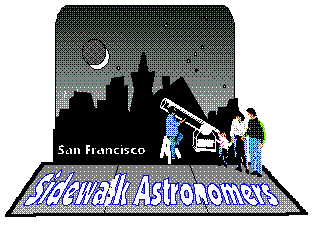Before you go out to the sidewalk...
Educate yourself, then you can inform, even entertain, others!
As soon as you put your telescope on the sidewalk and
invite passersbys to "take a peek," you'll notice several things, not the least
of which how appreciative most folks are (and how many have never looked through a
telescope); but even more significantly, you'll notice how many questions people have. It
is important that you have answers.
The following are some of the most common questions:
1) How far can you see with that telescope?
2) What power is that telescope?/ How much did it cost?
3) Why are you doing this?
4) Are those moons around [Saturn, Jupiter] ?
5) What is the difference between a star and a planet?
6) Do you believe in UFO's ?
7) Do you believe in astrology?
8) Why is [Venus, the Moon...] moving?
9) What constellation is that?
10) What are "shooting stars"?
Be spontaneous, be creative... Do a little research... Try to
answer questions in a manner that folks will understand and remember. If they don't ask
questions, do an "Alex Trebek," give them answers!
Many of the most entertaining sidewalk astronomers have little
stories to tell, which help people remember some of the answers:
"If you were in a spaceship going 60 miles an hour 24 hours a day:
It would take you almost six months to get to the moon;
180 years to get to the Sun
757 years to get to Jupiter;
1,535 years to get to Saturn:
50 million years to get to the nearest star!"
Visualized scale models are also useful:
If the Sun were the size of a bowling ball (8" diameter);
Mercury would be a "pinhead" 10 yards (paces) away;
Venus, the size of a "peppercorn," 19 yards away;
Earth another "peppercorn," 26 yards away;
Mars, a peppercorn 40 yards away;
Jupiter, a "chestnut" 135 yards away;
Saturn, an "acorn" 247 yards away;
Uranus, a "peanut" 496 yards away;
Neptune, another peanut, 777 yards away; and
Pluto, a pinhead, would be 1019 yards,
over half a mile (mile=1760 yards) from a bowling ball sized Sun.
The nearest bowling ball sized star would be 4,300 miles
away--the average distance between stars in our Milky Way galaxy.
(1,000 miles=1 light year with this model).
[from Guy Ottewell's The Thousand -Yard Model ]
A scale model I've adopted from Robert Burnham's excellent
3-volume Celestial Handbook, shrinks the distance between the Sun and Earth
(Sun=8"; Earth=peppercorn, 26 yards away, from above, remember?) down to one-inch
away! On this scale, the Sun is a mere pinpoint of light, the whole solar system is about
two yards in diameter, and a light-year equals a mile! This means the nearest
pinpoint-star would be about 4.3 miles away!
To get an idea of the size of our galaxy, Burnham shrinks the scale model down even
further:
Now the the Earth-Sun distance is 1/30 of an inch;
Our solar system is two inches in diameter;
Billions of stars are scattered, on average, every two-hundred yards;
The entire Milky Way (our galaxy), on this scale,
would be the size of North America!
As you can see, the distances between stars in galaxies are
enormous (even within a scale model). The distances between galaxies are not so great, at
least relatively speaking: The distance to our nearest large galaxy, Andromeda (2.4
million light years), is about 24-times the Milky Way's diameter (100 thousand light
years). If your fist were the Milky Way, hold it high over your head--Andromeda would be
another fist-sized galaxy at your feet!!
How about numbers? How can we get an idea of what a million, or
billion of anything is? Again, a scale model is useful here. David Chandler, in his
booklet, Exploring the Night Sky with Binoculars, uses a grain of sand as a unit:
One thousand grains of sand lined up would be about a yard long;
A square-yard, one grain of sand thick, would be about a about a million grains of sand;
a cubic yard would be about a billion grains of sand!
It is estimated there are 100-300 billion stars in our Milky Way galaxy.
perhaps 50 billion galaxies are within the grasp of the Hubble Space Telescope.
Bring a reference book with you (one with pictures or maps is
useful, especially if you will be looking at the moon). Write some notes down--perhaps
even tape some of these scale models to your scope!
HOME |

